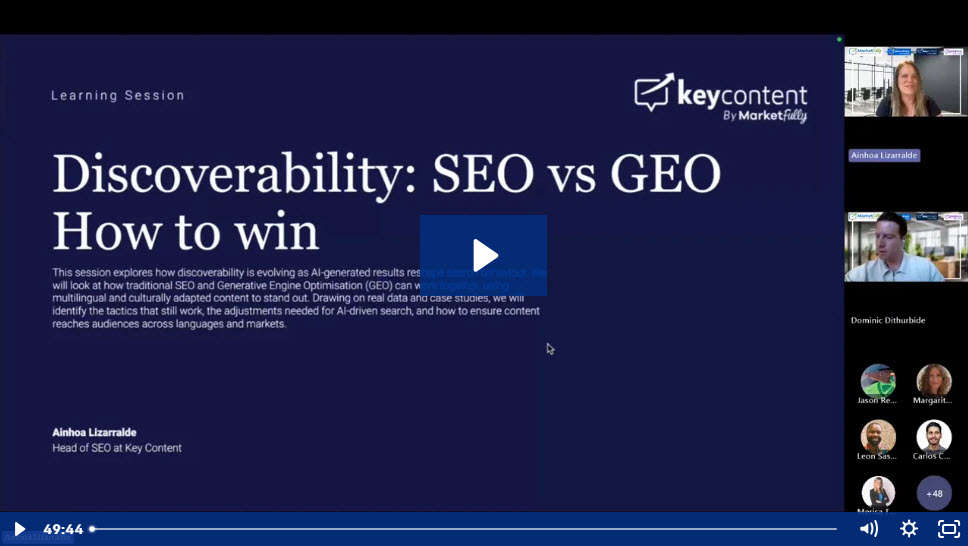Speaking your audience’s language is about more than just translation in today’s global digital ecosystem, it’s about using localised, relevant, and purposeful content to truly connect to your audience. 76 percent of consumers prefer to buy from sites that offer information in their native tongue, which is a huge chunk of the global market.
By making content accessible and readable for everyone, regardless of their primary language, businesses can significantly improve the customer experience, eliminate potential confusion, and demonstrate a profound respect for cultural differences.
Research and planning is the first step to creating a successful multilingual content strategy. This blog walks you through how to set the foundation: from KPIs and buyer personas to developing your message and planning workflows that are most effective for a global market.
1. Setting up KPIs and objectives
A successful multilingual content marketing strategy begins with a clear understanding of the target markets and the specific goals the business aims to achieve within those markets. Identifying the audience, their preferences, and the languages they are most comfortable using is important for effective engagement. This process requires conducting thorough market research to uncover regional consumer behaviours and trends.
Analytics tools, like Google Analytics, play a vital role in this stage by giving us valuable insights into a website’s visitors, including their geographical locations and language preferences.
How to set effective KPIs and objectives
Once the target markets have been identified, the next crucial step is to define clear and measurable objectives. Objectives are the main goals you want to achieve with your multilingual content marketing strategy, like increasing brand awareness in a new market or driving sales in a specific region. These objectives should follow the SMART framework, making sure they are Specific, Measurable, Achievable, Relevant, and Time-bound.
- Specific: Clearly define what you want to achieve in each target language. For example, instead of saying “increase website traffic,” aim for “increase website traffic from Spanish-speaking users by 15%”.
- Measurable: Identify the key metrics that will indicate the success of your content strategy in each language. These might include website traffic from specific regions, engagement rates (likes, shares, comments) on localised social media, the number of leads generated from multilingual content, or conversion rates for different language versions of your website.
- Achievable: Set realistic goals that are attainable based on your resources and the specific characteristics of each target market. Consider the market size, competition, and your current reach in each language.
- Relevant: Make sure your content goals align with your broader business objectives in each market. For instance, if you’re launching a new product in France, your content goals for the French market should focus on generating awareness and driving initial sales for that product.
- Time-bound: Define a timeline for getting to each goal. For example, aim to “increase website traffic from Spanish-speaking users by 15% within the next six months”.
Establishing your Key Performance Indicators (KPIs) is an essential part of tracking your progress towards your objectives. These are quantifiable metrics that will help you measure your progress. These include things like website traffic segmented by language, engagement rates (likes, shares, comments) on localised social media content, the number of leads generated from multilingual content, conversion rates for different language versions of the website, and the customer acquisition cost in various target markets.
| SMART Goal Example | Relevant KPIs |
| Increase website traffic from Spanish-speaking users by 15% in 6 months | Website traffic from Spain and Latin American countries, bounce rate on Spanish pages, average duration on Spanish pages |
| Generate 50 new leads from French-speaking markets within Q3 | Number of form submissions in French, conversion rate of French landing pages, cost per lead from French campaigns |
| Improve engagement on Japanese social media posts by 20% in 1 quarter | Likes, shares, comments on Japanese social media posts, reach of Japanese social media content |
Using the One Metric That Matters system
To further refine the focus of a multilingual content marketing strategy, the “One Metric That Matters” (OMTM) framework can be invaluable. OMTM represents a single, crucial metric that the team will focus on to drive success over a specific period. This approach helps to concentrate time and energy on what truly drives growth, leading to faster results and a more significant long-term impact.
There are several steps that go into identifying OMTM for a multilingual content strategy, including the Pirate Funnel and determining specific segments for each language being targeted. The Pirate Funnel stage includes stages of Awareness, Acquisition, Activation, Revenue, Retention, and Referral. By analysing performance at each stage for different language markets, businesses can pinpoint where their efforts are falling short.
| Funnel Stage | Potential OMTM (by Language) |
| Awareness | Percentage increase in website traffic from organic search (Spanish), Growth in social media reach/impressions (French) 13 |
| Acquisition | Number of qualified leads generated per month (German), Conversion rate of website visitors to trial sign-ups (Japanese) 13 |
| Activation | Percentage of new trial users who complete key onboarding steps (Portuguese), Users completing core feature usage (Mandarin) 13 |
| Revenue | Marketing qualified leads to customer conversion rate (Italian), Customer acquisition cost as a percentage of LTV (Korean) 13 |
| Retention | Percentage of existing customers engaging with marketing emails/content (Russian), Reduction in churn rate (Arabic) 13 |
| Referral | Number of referrals generated per month (Dutch), Net Promoter Score (Swedish) 13 |

2. Developing your multilingual content marketing core message
With a clear understanding of the target audience, well-defined objectives, and a focused metric guiding efforts, the next step is to develop a compelling narrative that resonates across cultures. This involves creating a core brand message that can be adapted for various audiences.
Establishing a solid foundation for international content marketing requires a clearly defined and consistently communicated core brand message. This core message should cover key elements like the unique value proposition, the brand’s voice and tone, the overarching tagline, and the strategic positioning statement of the brand.
Effective multilingual content marketing requires adapting the message to suit the cultural nuances, values, and preferences of each target audience. Successful examples of cultural adaptation include Coca-Cola’s “Share a Coke” campaign, which personalised labels with local names and phrases , and IKEA’s multilingual catalogues, which adapt visuals and product information to suit regional preferences.
How to establish a solid brand foundation
- Clarify your value proposition
What problem are you solving, and why should people trust you? Clarifying your value proposition means pinpointing what unique benefits your brand offers to your target audience across all languages and cultures. - Achieve internal alignment
Achieving internal alignment makes sure all teams understand and embrace your brand’s core values and messaging, guaranteeing a consistent voice in every language. - Test and refine
Get feedback from regional teams, test headlines and CTAs in target markets, and refine messaging accordingly. Testing and refining involves gathering feedback on your multilingual messaging and adapting your approach to resonate with diverse audiences.
3. Style guides: global consistency, local relevance
If you want to maintain a consistent brand identity across all regions and languages, you must develop and implement comprehensive style guides, which will serve as a central reference point for all content creators, developers, and translators and make sure your brand voice and messages stays consistent across the board.
A comprehensive multilingual style guide should include several key elements, including fundamental general translation guidelines like rules for style, sentence structure, spelling, capitalisation, tone of voice, grammar, and punctuation. It’s also important to outline the nuances of the brand or message, specify words or expressions to avoid, provide guidance on handling idioms and jargon, and address culturally specific references.
The style guide should also prepare solutions for potential grammar ambiguities and establish grammar rules specific to the brand. Here are some examples of how to go about putting your style guide together:
| Component | Description/Examples |
| Tone of voice | Specifies whether the brand should sound formal, friendly, authoritative, playful, etc. |
| Grammar and punctuation | Outlines rules for sentence structure, spelling conventions, use of commas, hyphens, etc. |
| Terminology | Lists approved translations for key terms, product names, and industry-specific vocabulary |
| Cultural considerations | Provides guidance on cultural nuances, taboos, symbols, and idiomatic expressions to avoid misunderstandings |
| Formatting | Specifies preferences for date formats, numbering styles, use of bullet points, etc. |
Being consistent across languages and cultures is important, but consistency doesn’t mean one-size-fits-all. Cultural preferences and local expectations matter when creating content for specific countries or languages. Rather than building entirely separate style guides for each market, which can lead to a fragmented brand, consider creating flexible content brief templates that maintain your brand voice but allow for regional adaptation and include cultural considerations.
For example:
- In Germany, clarity and detailed information may take priority over a playful or humorous tone.
- In Brazil, emotionally driven storytelling may be more effective at creating connection.
- In Japan, trust is often built through culturally relevant testimonials and local case studies.
This approach will make sure that local content still feels authentically “you”, but expressed in a way the local market will resonate with the most.

4. Creating Buyer personas for each market
It’s absolutely essential to know your audience if you want to create content that resonates with local users. Think about cultural norms, buying behaviours, and content preferences, rather than assuming a one-size-fits-all approach.
Identify core markets and audiences
Before diving into persona details, pinpoint the key markets you’ll be targeting with your multilingual content. This involves understanding where your product or service has the most potential and who the primary customer segments are within those regions.
- Define Target Geographies: List the specific countries or regions you intend to reach.
- Identify key audience segments: Determine the distinct groups of potential customers within each target geography. Consider factors like demographics, job roles, and needs.
- Market research: Conduct initial research to understand the size, growth potential, and existing competition within each identified market.
- Prioritise markets: Based on your research, prioritize markets based on factors like potential ROI and strategic importance.
Analyse local culture and preferences
Understanding the nuances of each target market’s culture and preferences is of utmost importance when your aim is effective communication. Content that resonates in one culture might fall flat or even offend in another.
- Cultural norms and values: Research the main customs, traditions, social etiquette, and core values of each target market.
- Communication styles: Understand preferred communication styles, including directness vs. indirectness, formality, and humour or emotional appeals are used.
- Language nuances: Go beyond literal translation and consider idiomatic expressions, slang, and linguistic sensitivities.
- Content consumption habits: Investigate how your target audience in each market prefers to consume content (e.g., social media platforms, blogs, video, print).
- Local trends and interests: Identify current trends, popular topics, and local interests that can inform your content strategy.
Create Region-specific personas for a multilingual content marketing campaign
You can now develop detailed buyer personas tailored to each region based on your market and cultural analysis. These personas represent your ideal customers within those specific markets.
- Demographics: Define age range, gender, education level, income, and location-specific demographic information.
- Professional background: Outline their job title, industry, company size, and career goals.
- Psychographics: Explore their values, attitudes, interests, lifestyle, and opinions relevant to your product or service.
- Needs and challenges: Identify their pain points, challenges they face, and what motivates them.
- Goals and aspirations: Understand what they are trying to achieve both personally and professionally.
- Information sources: Determine where they go for information, including websites, social media, industry publications, and influencers.
- Language preferences: Clearly state their preferred language(s) for communication and content consumption.
- Decision-making process: Understand their typical buying journey, who influences their decisions, and their key considerations. Quotes and Motivations: Include representative quotes that reflect their thoughts, feelings, and motivations.
5. Final Thoughts
In conclusion, developing a successful multilingual content marketing strategy requires a systematic and thorough approach. It starts with in-depth research to understand the global audience and their specific needs and preferences in each target market.
Next, set clear, measurable objectives and identify the One Metric That Matters for each language to focus efforts and track progress effectively. Developing a core brand message that can be adapted and localised for different cultures is a way to make sure your brand stays consistent and relevant.
To maintain quality and make sure your content is uniform across platforms, implement multilingual style guides that incorporate cultural nuances for each target market.
Next, gain a deeper understanding for each market by developing detailed buyer personas for each market. Finally, analysing local culture and preferences is the best way to make sure content resonates authentically with the audience.
By diligently following these steps, businesses can build a strong global content presence, engage with diverse audiences, and achieve significant growth in international markets.
At Key Content, we help businesses design and implement tailored multilingual content strategies that drive real results across global markets. From research and planning to localised content creation, we ensure your brand connects authentically with every audience.
Get in touch today to start growing your global content presence.





